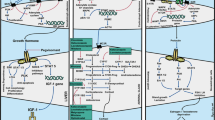Summary
Adrenal androgens are discussed as a reason for tumor progression after androgen ablation therapy. Because of the difference in the secretion of androgens by the adrenals of humans and rats, there is no reliable tumor model to study the role of adrenal androgens in tumor progression. Therefore, the main adrenal androgens were administered to rats in order to mimic human endocrine conditions. Application of dehydroepiandrosteron-sulfate (DHEA-S) alone or a mixture of androstendione (A), 11β-hydroxyandrostendione (OHA), dehydroepiandrosterone (DHEA), and its sulfate (DHEA-S) to castrated rats caused only a slight increase of prostate and seminal vesicle weights. Contrary to these findings, growth of the R3327 prostatic carcinoma in castrated rats was greatly stimulated by these adrenal androgens up to the level of the intact control. Thus, in spite of androgen ablation, tumor progression could be induced by exogenous adrenal androgens.
Similar content being viewed by others
References
Abraham GE, Manlimos FS, Garza R (1977) Radioimmunoassay of steroids. In: Abraham GE (ed) Handbook of radioimmunoassay. Marcel Dekker, New York, p 591
Bélanger B, Bélanger A (1987) Rat adrenals do not secrete significant amounts of precursor androgens: comparison with man. J Endocrinol Invest 10 [Suppl 2]:67
Blaquier J, Forchielli E, Dorfman RI (1967) In vitro metabolism of androgen in whole human blood. Acta Endocrinol [Copenh] 155:697
Block NL, Trump D, Rose DP, Cummings KB, Hogan TF (1984) Evaluation of aminoglutethimide in stage D prostate cancer: an assessment of efficacy and toxicity in patients with tumors refractory to hormonal therapy. Cancer Treat Rep 68:719
Brisset JM, Bocon-Gibod L, Botto H (1987) Anandron (RU23908) associated to surgical castration in previously untreated stage D prostate cancer: a multicenter comparative study to two doses of the drug and of a placebo. In: Murphy GP, Khoury S, Küse R, Chatelain C, Denis L (eds) Prostate cancer, part A: research, endocrine treatment, and histopathology, Liss, New York, p 411
Ellis WJ, Isaacs JT (1985) Effectiveness of complete versus partial androgen withdrawal therapy for the treatment of prostatic cancer as studied in the Dunning R-3327 system of rat prostatic adenocarcinomas. Cancer Res 45:6041
Fiet J, Gourmel B, Vilette JM, Brerault JL (1980) Simultaneous radioimmunoassay of androstendione, dehydroepiandrosterone and 11β-hydroxyandrostendione in plasma. Horm Res 13:133
Geller J, Albert J, Yen S (1978) Treatment of advanced cancer of the prostate with megestrol acetate. Urology 12:537
Harper ME, Pike A, Peeling WB, Griffiths K (1974) Steroids of adrenal origin metabolized by human prostatic tissue both in vivo and in vitro. J Endocrinol 60:117
Harper ME, Peeling WB, Griffiths K (1978) Adrenal androgens and the prostate. J Endocrinol Invest 10 [Suppl 2]:9
Isaacs JT, Coffey DS (1981) Adaption vs selection as the mechanism responsible for the relapse of prostatic cancer to androgen ablation therapy as studied in the Dunning R-3327-H adenocarcinoma. Cancer Res 41:5070
Isaacs JT, Coffey DS (1983) Model systems for the study of prostatic cancer. Clin Oncol 2:479
Kyprianou N, Isaacs JT (1987) Biological significance of measurable androgen levels in the rat ventral prostate following castration. Prostate 10:313
Kyprianou N, Isaacs JT (1987) Quantal relationship between prostatic dihydrotestosterone and prostatic cell content: critical threshold concept. Prostate 11:41
Labrie F, Dupont A, Bélanger A, Lacourciere Y, Raynaud J-P, Hasson JM, Gareau J, Fazekas AT, Sandow J, Monfette G, Girard JH, Emond J, Houle (1983) New approach in the treatment of prostate cancer: complete instead of partial withdrawal of androgens. Prostate 4:579
Labrie F, Dupont A, Bélanger A (1985) Complete androgen blockade for the treatment of prostate cancer. In: De Vita TH, Hellman S, Rosenberg SA (eds) Important advances in oncology. Lippincott, New York, p 193
Menon M, Walsh PV (1979) Hormonal therapy for prostatic cancer. In: Murphy GP (ed) Prostatic cancer. PSG, Littleton, p 175
Moguilewski M, Fiet J, Tournemine C, Raynaud J-P (1986) Pharmacology of an antiandrogen, Anandron, used as an adjuvant therapy in the treatment of prostatic cancer. J Steroid Biochem 24:139
Punjabi U, Deslypere JP, Verdonck L, Vermeulen A (1983) Androgen and precursors levels in serum and testes of adult rats under basal conditions and after hCG stimulation. J Steroid Biochem 19:1481
Sandberg AA (1980) Endocrine control and physiology of the prostate. Prostate 1:109
Sanford EJ, Paulson DF, Rohner TJ, Drago JR, Santen RJ, Bardin CW (1977) The effects of castration on adrenal testosterone secretion in men with prostatic carcinoma. J Urol 118:1019
Schneider MR, Hartmann RW, Sinowatz F, Amselgruber W (1986) Nonsteroidal antiestrogens and partial estrogens with prostatic tumor inhibiting activity. J Cancer Res Clin Oncol 112:258
Schneider MR, von Angerer E, Höhn W, Sinowatz F (1987) Antitumor activity of antiestrogenic phenylindoles on experimental prostate tumors. Eur J Cancer Clin Oncol 23:1005
Sommerville IF, Flamigni C, Collins WP, Koullapsie EN, Dewhurst CJ (1971) Androgen metabolism in human skin. Proc R Soc Med 64:845
Trachtenberg J (1985) Optimal testosterone concentration for the treatment of prostatic cancer. J Urol 133:888
Weibel ER (1979) Stereological methods. Vol 1: practical methods for biological morphometry. Academic, London
Author information
Authors and Affiliations
Rights and permissions
About this article
Cite this article
Schiller, CD., Schneider, M.R., Hartmann, H. et al. Growth-stimulating effect of adrenal androgens on the R3327 Dunning prostatic carcinoma. Urol. Res. 19, 7–13 (1991). https://doi.org/10.1007/BF00294013
Accepted:
Issue Date:
DOI: https://doi.org/10.1007/BF00294013




